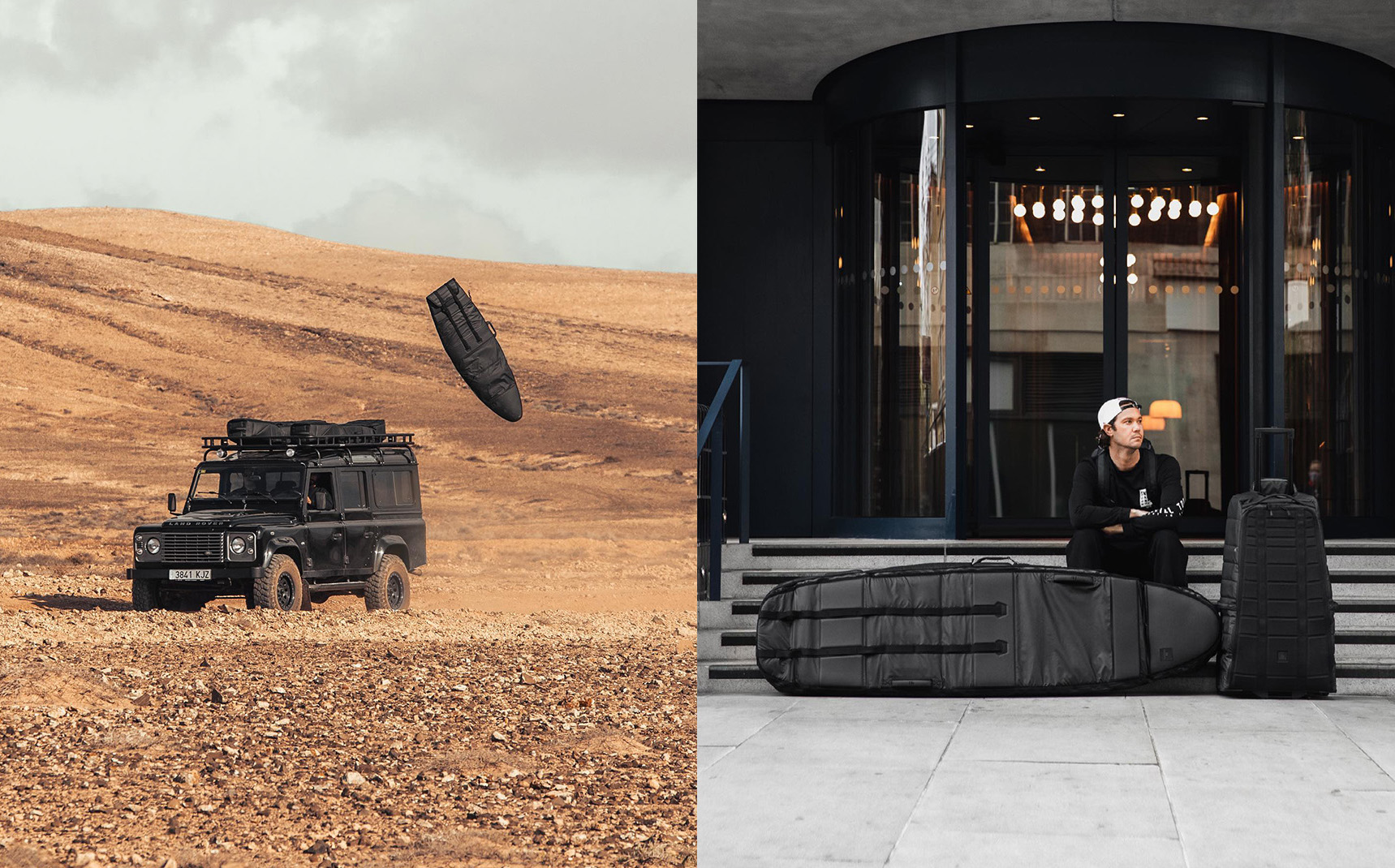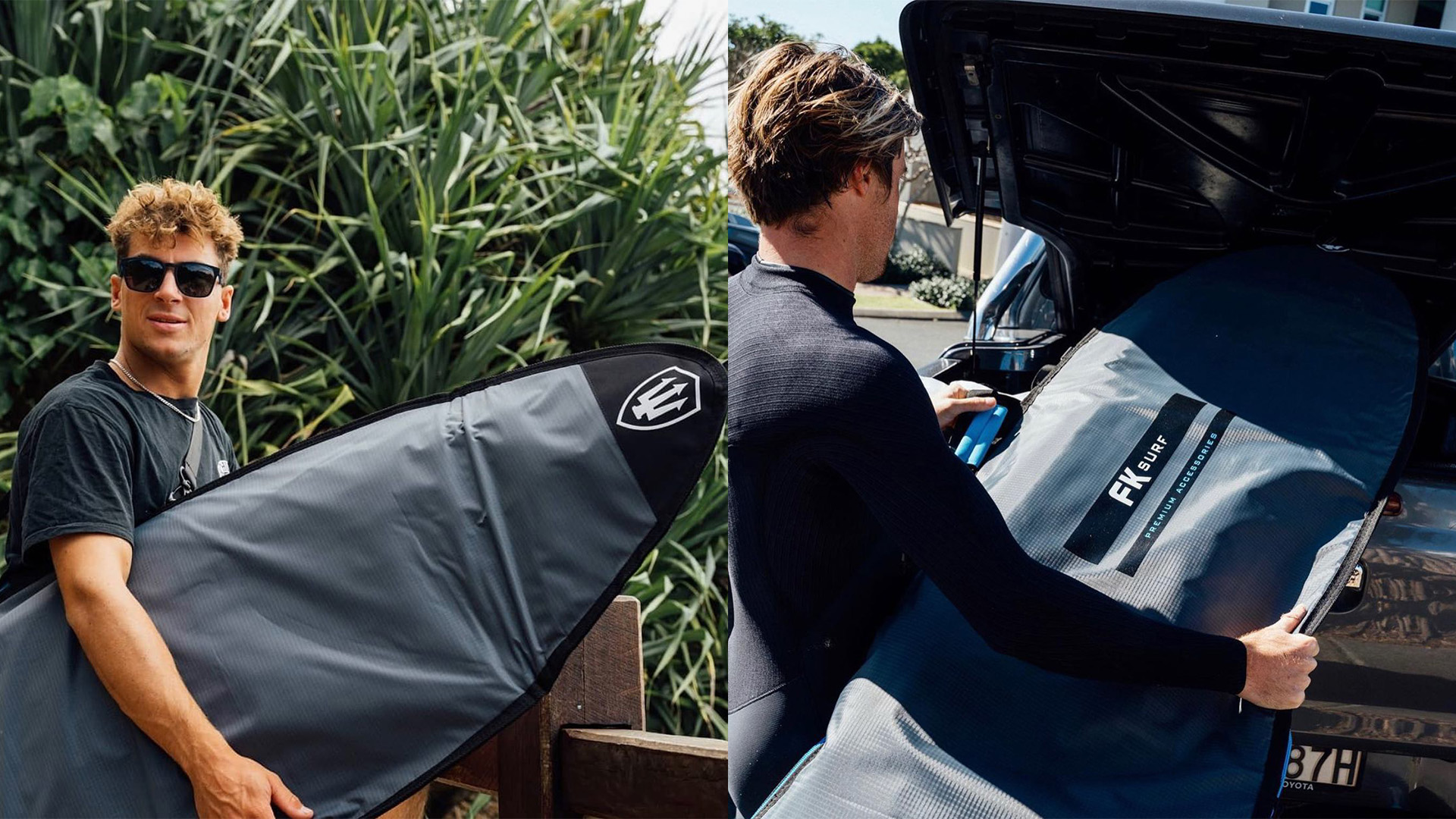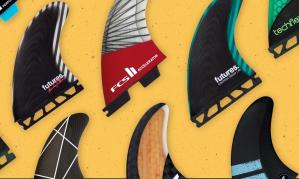Surfboard Bag Guide
Why Get a Board Bag, Is it Necessary?
 DB Bags are some of the toughest on the market.
DB Bags are some of the toughest on the market.
The simple answer is yes. Leaving the board bare and exposing it to all sorts of physical elements can be risky. Surfboards are fragile and regardless of the distance of travel, whether the beach is nearby or you need a Surfboard Travel Bag for an overseas plane flight, you always want to ensure your boards arrive safe. There's nothing worse then travelling somewhere with your boards and they get damaged. On that note, it can also be a good idea to take Surfboard Repair Kit when travelling as this can be trip saver, if your board does end up getting damaged.
Getting a surfboard bag can prevent dings and nicks or having a broken board. Investing on a good surfboard bag can also prolong the life of the board from unnecessary exposure to the elements. It protects the board from the sun and heat while keeping it insulated against any damage when not in use.
What Size Surfboard Bag Should I Get?
The simplest way to keep your surfboard safe and prolonging its life is by storing it in a bag or cover. Surfboards vary in shapes and sizes and finding the perfect fitting bag can be challenging. A good bag should easily be able to store and protect the ‘entire’ surfboard and easily slide inside.
When selecting a surfboard bag, you should not only consider the size but also the shape of the surfboard and other essentials that will be placed inside the bag. The first thing you should check are the surfboard’s dimensions; length, width, and thickness of the board. Of the three, the length is the most important since bags are usually listed by length. The width and thickness, on the other hand, can affect the style of the bag.
Bags come in various styles and sizes and if the surfer doesn’t exactly know what style their board is then knowing its dimensions can be extremely useful. Regardless of the type of board, the surfboard bag must be able to fit properly to adequately protect the board.
If the bag that is too small or too tight then taking or returning it can be a struggle. A bag that is too big can make safely transporting the surfboard difficult because it tends to be too loose and can actually damage the board. The ideal surfboard bag for a surfboard is one that lets the board easily slide inside and outside while keeping the board’s movement very minimal when inside the bag.

FCS make some of the most robust board bags for travel.
Types of Board Bags
Shortboard Bags
These bags are designed for boards that have a width of less than 19 inches.Hybrid Board Bags
This type of board bag is great for boards that have a standard shortboard shape but also has a little more width to it.Fish/Retro Board Bags
These bags will fit boards that have a wider general outline including a wider nose and tail and come in models like the FCS Day Fun Board Bag.
Longboard Bags
These are the big boys needed to fit your biggest and longest templates when you need to protect them from the elements. Longboard Covers will range from 8ft to beyond 10ft.
Soft Board Bags
Or foam board bags are necessary to prevent elemental damage to the exposed foam construction, reduce near and far travel wear, and eliminate strap indents on the rails when locked to a roof rack. Keep in mind to check the width of the bag as Softboard Surfboards are always wider and thicker than traditional fibreglass surfboards
Difference Between Types of Surfboard Bags
Surfboard Socks
Surfboard Socks, also called stretch covers, are soft woven fabric covers that are less than 2 millimeters thick and considered as the most lightweight surfboard bags. They are usually used for safe storage of surfboards in a surfboard rack or within a surfboard travel bag for added protection.
Its primary purpose is to give protection to the board against the sun and any light scratches and dust. This type of bag is perfect for those who would like to simply shove the board inside the car without damaging the car’s interior.
Surfboard socks are made from different materials, ranging from soft woven fabrics or canvas and use a drawstring as a simple closure mechanism and polyester as a nose protector. This type of board cover is good for short trips and local surfs. For long trips, surfboard socks can be used as an extra layer of padding when placed inside a day bag or travel bag for long flights. This bag may only offer little protection when traveling, but its main purpose is to protect the surfboard from any scratch, wax, dust, and also from the UV light. Learn more in our Ultimate Guide to Surfboard Socks.

Day Board Bags
Day board bags are the most common go-to bag for daily usage. This is because they are lightweight and considered perfect for protecting the surfboard whether placed inside the car or on the roof rack. This is a popular choice among surfers who would like to protect their surfboards from almost everything.
Day board bags are normally made from a polyester, an exceptionally durable material that comes with a white or reflective tarp under its side. It also comes with a detachable or fixed shoulder strap and also a grab handle. These bags have a white or reflective silver on its side that is used to reflect the sunlight and heat. It also protects the surfboard from any de-lamination while preventing the wax from melting.
A day board bag is considered an all-rounder board bag because it is perfect for road trips and as a storage for the surfboard.
 Check out FK Surf Day Use board-bags.
Check out FK Surf Day Use board-bags.
Surfboard Travel Bags
Similar to day board bags but 10 millimeters thicker in padding. This creates a thicker layer of protection when it comes to longer trips and greatly reduces the surfboard’s risk for damage. Surfboard Travel Bags are made of well-constructed durable polyester which provides its strength.
Similar to the day bags, it also has a reflective tarpaulin on its underside and reinforcement is present for extra protection on its nose. It is suitable for longer trips and for boards that need more protection than a day board.

Filipe Toledo utilising a range of different FCS board bag types for the ultimate board protection. A Board Sock for each board inside your travel bag is the recommended way to travel.
How to Choose a Surfboard Bag
Dimensions
This is one of the most critical factors that must be taken into consideration when it comes to choosing a surfboard bag. When it comes to dimensions the length is the most important measurement to remember since this will be used to determine the bag’s mark. A good tip is to buy a surfboard bag that is a few inches longer than the length of your surfboard.
The second thing to check is your surfboard’s width. Shortboards, for example, are similar in length, but widths may differ depending on the specific type of surfboard. The best way to get the perfect fitting bag is to bring your surfboard to the store or compare measurements of your board with the bag’s dimensions.
Fins
It’s not just the surfboard’s size but of equal importance is your fin’s configuration which should be considered when buying a surfboard bag. Quads fins have a bigger footprint and require more room at the tail of the bag. Single fins might require a zipper for the fin to poke through.
Zipper
A malfunctioning or poor-quality zipper could scratch the surfboard or might cause the owner to simply replace the surfboard bag altogether which is a total waste of money. The bag will not serve its purpose if it won’t open or close.
Salt (NaCl) is composed of two elements, sodium (Na) and (Chloride). And the chloride contained in seawater causes corrosion in metal zippers. The fact is that seawater causes more damage to metal than rust. Good alternatives to metal zippers are those that use plastics in their construction. The AQUASEAL® zipper from YKK, for example, is made from high-quality plastics and half the weight of metal zippers. Making them ideal for use in water sports and saltwater conditions.
So, the next time you purchase a surfboard bag be sure to check it has a good zipper that is built to last.
Padding
This layer of protection plays a big role in keeping your surfboard safe by absorbing any drops or bumps. It serves as the bag’s inner protector and prevents any dings or cracks thus prolonging the life of the surfboard.

What Thickness for your Surfboard Bag?
Heavyweight Bags
Generally best for air travel. They will normally be around 10mm thick giving you plenty of padding for when you want to fly your boards somewhere. Don't rely on gentle baggage handlers; instead make sure you're prepared with a nice thick Surfboard Bag.Lightweight Surfboard Bags
Great for everyday use. When you're throwing your boards on the roof or in the back of the van, the reflective side for your lighter-weight surfboard bag will ensure you're protected without needing the full 10mm thickness to lug round. Lightweight Bags are generally 5mm in thickness and, as mentioned, generally have one side with a reflective material to reduce heat stress like the Universal Day Use Bag by Creatures of Leisure.
Surfboard Socks or Surfboard Sox
Great even-lighter-weight covers for your boards when you're most worried about getting wax on everything. While they do offer some protection, they're certainly not as padded as the lightweight covers. Surfboard Socks are broken into a two categories based off the material used: Stretch and Non-Stretch.
Surfboard Stretch Covers have a stretchy nature and a soft feel, like a traditional sock. These Stretch Covers, like the Stretch Socks by FK Surf, ensure you can move your board around without getting too much wax on everything else.
Non-stretch are often the Canvas Board Covers which are not stretchy, and instead offer a bit more protection due to the more rugged material used. They still feature a reinforced padded nose, but the canvas material is much more durable, it will protect better against rips and is waterproof and wax proof. For example, check out the collection of canvas surfboard covers from Boardsox which all include a 5mm padded nose and durable 16oz canvas material.
To learn more about this type of board cover, check out Surfboard Socks.
Canvas Board Covers
Relatively new to the range of board cover options, Canvas board bags are basic day use covers that can be an alternative to the traditional surfboard sock / stretch cover. As the name suggests, Canvas board covers are made from a durable canvas fabric that is much stronger than the material found in the socks and results in more protection for your board. When comparing with stretch covers, the down side to the canvas board bags is that they are generally more expensive and not flexible (stretchy) so you will want to ensure the size you get fits your board.For some idea of the typical features found on a canvas board bag, check out the options from Boardsox and Wasabi Canvas Surfboard Covers.
 Check out Boardsoxand Wasabi Originals for canvas board covers.
Check out Boardsoxand Wasabi Originals for canvas board covers.
How Many Boards in your Surfboard Bag?
Choosing the right amount of surfboard capacity for your board bag can be tricky. There is a large range of bags out there including Single Day Use Board Bags, Universal Double Bags, Triple Bags, Quad Surfboard Bags with Wheels and Multi-tour bags.
Single Day Use Bag
These bags are great for just one board at a time.Double Surfboard Bags
These bags are for transporting two surfboards and generally have a divider inside.Quad Surfboard Bags with Wheels or Quad Wheelies
These boards are great for air travel when you have connecting flights. They can take 4 boards generally and have built in wheels to help you get around those airport terminalsMulti Tour Bags
These bad boys are for your hardcore surf adventures. With a general capacity for 3 boards including their fins or 6 boards without fins, you can basically bring your whole quiver with you.Understanding Surfboard Bag Lengths
The length of your Surfboard board bag, is an easy one to figure out. Basically, the board bag length is to suit boards that length and smaller. While you can sometimes fit in larger surfboards, why bother? If you have a 6'8" Surfboard, then grab yourself a 6'8" surfboard bag.
Surfboard socks on the other hand give you a bit of leeway. The general rule is that you can throw a sock on anything with about 3 inches of leeway either way. So if your surfboard sock is 6'7", you can get away with using it generally for 6'4" to 6'10" boards.
While you're looking at Surfboard Covers make sure you also check out the Board Calculator to ensure you are riding the right board for you and see what other models are out there to suit your individual skill level.
Boardcave is an online distributor for premium surf accessory brand Creatures of Leisure
Foamie Surfboard Bags
Foamies are super durable and less susceptible to severe dings, but many surfers assume that this foam construction means less need to correctly store and protect their board. Just as well, foamies are often the go-to choice for new, beginner surfers who might not know the necessity of foamie surfboard bags.
If you want to extend the longevity of your foamie, maintain its performance efficiency, and make the most out of your money, then we highly suggest utilising the same amount of protection for a foamie as you would any other board!
The foam construction of a foamie surfboard might mean a bump on the rails won't hurt it as bad as a polyester or epoxy surfboard, but the foam will lose its hardiness over time due to sun exposure, and potential dry rot due to water build up. For simple and safe storage from the elements and to easily toss your foamie in the car without worrying about wax and sand on the seats, a surfboard sock is the ticket.
However, if you consistently use surfboard racks for your foamies, you should add an extra layer of protection with a legitimate lightweight surfboard bag. When tightened, the straps place pressure on the foam rails causing damaging indents, and over time this will lead to irreparable damage. Tying the board down while in a lightweight surfboard bag will provide the protection necessary to simply avoid this detriment. Double this protection by simultaneously using a sock and a bag.
And of course, for travel's sake (I mean, who doesn't love getting pitted on a foamie in Mexico or Costa Rica?!), stick to a travel board bag, even with a foamie. Just take note that foamies are generally super thick, so you'll need a board bag with enough room to comfortably fit these chunky rails, especially if you plan on taking more than one board with you.
Surfboard Travel Packing Tips
When it comes to packing there are two possible approaches; either pack to its maximum or to just leave it bare. Most surfers often pack their surfboard together with other necessities such as towels, wetsuits, and extra clothes to pad out the bag and minimise any knocks while travelling.
Protect the Fins
The best way of protecting the fins is to simply remove them and pack the fins separately from the board. This is to prevent it from dinging the board during travel.
However, if the board has a glassed-on fin then adding an extra protection can be done by using a cheap piece of foam that is big enough to cover the fin. You could also cut a hole to safely place the fin inside.
Protect the Rails
Protecting the rails of the board is essential because it is one of the most vulnerable areas during any travel. The rails can be easily protected from any dings by using foam tubing and wrapping it around the rails and securing it with a tape. If there is no access to a foam tubing, then another way to protect the rails is by using bubble wrap and cardboard.
Protect the Board
A simple way of protecting the board is by wrapping it inside a bubble wrap and securing it with some tape. Another method is by placing a board sock or stretch cover. Wrapping towels around the board can also be done.
Wrapping multiple boards for a multi travel bag can be challenging. However, a good practice is to always wrap them separately or placing towels or bubble wraps between them.
Inserting the surfboard inside the surfboard bag
When placing a single board inside a bag, it is important to remember which side has been waxed. Placing a sticker on the side of the bag as a guide to remember what part of the surfboard should be facing which side.
For multiple boards, remember to pack every board in the same direction. Place the longest and heaviest board below and the shortest and lightest board above. Avoid large spaces between boards, noses, and tails. Use paddings such as soft clothing or bubble wraps to fill in the gaps and minimise their movement. Most multi travel bags have an internal strap for the boards for added security. Apply the right amount of pressure between the boards and be careful not to over tighten it which can damage the boards.
Label the surfboard bag
Placing a label both on the board and bag is essential because missing one can be as bad as damaging it. Placing a luggage tag that contains all the necessary information of the owner can help. Attaching an additional fragile strap, tag, or a sticker can also make for easier identification.
Steps to Remember When Packing
1. Fly with a reputable airline. Some airlines have a worse rep then others when it comes to flying with Surfboards, consider your options and check out their baggage policies.
2. Get the right bag for you boards. You want to make sure the board bag isn’t too small or too big. Too small and it won’t allow for a little wiggle room, too big and your boards will more than likely get flung around like a sausage down a hallway. Look for something 4-6in bigger than the biggest board your taking, and make sure to secure the boards tightly with tie-down straps inside for added protection during your travels.
3. Pack em' right, keep em' tight! Make sure your rails, tip and tail are covered. For rails, an extra safe coverage is pool noodles. Cut down the middle and then attach them to your board, hold them in place with little duct tape if needed. Cover the tips and tails with as much padding as possible, this could be wetsuits, boardies towels or just plain old cardboard. Next make sure your fins are removed and stick a towel between your boards for a little extra padding. It's never a bad idea to tape your bag with fragile stickers, carriers are lugging bags in and out all day and anything extra to prevent rough handling is recommended.
Helpful Surfboard Board Bag Links
>> Check out the Baggage Allowances and fees and charges for a variety of flights and destinations through Air Asia simple to use Fee Calculator.
>> Also have a look at Qantas for their Sporting Equipment rates and charges.
Boardcave has a large range of Surfboard Bags to suit your needs and we have decided to put together a Surfboard Bag Guide to ensure you get the right bag for what you want to do with your surfboard. Check out our Sales Page for cheap Surfboard Bags.
Popular Surfboard Bags
Shop All Surfboard Bags















